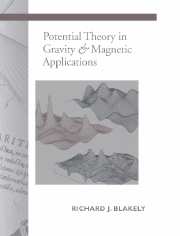Book contents
- Frontmatter
- Contents
- Introduction
- 1 The Potential
- 2 Consequences of the Potential
- 3 Newtonian Potential
- 4 Magnetic Potential
- 5 Magnetization
- 6 Spherical Harmonic Analysis
- 7 Regional Gravity Fields
- 8 The Geomagnetic Field
- 9 Forward Method
- 10 Inverse Method
- 11 Fourier-Domain Modeling
- 12 Transformations
- Appendix A Review of Vector Calculus
- Appendix B Subroutines
- Appendix C Review of Sampling Theory
- Appendix D Conversion of Units
- Bibliography
- Index
11 - Fourier-Domain Modeling
Published online by Cambridge University Press: 10 October 2009
- Frontmatter
- Contents
- Introduction
- 1 The Potential
- 2 Consequences of the Potential
- 3 Newtonian Potential
- 4 Magnetic Potential
- 5 Magnetization
- 6 Spherical Harmonic Analysis
- 7 Regional Gravity Fields
- 8 The Geomagnetic Field
- 9 Forward Method
- 10 Inverse Method
- 11 Fourier-Domain Modeling
- 12 Transformations
- Appendix A Review of Vector Calculus
- Appendix B Subroutines
- Appendix C Review of Sampling Theory
- Appendix D Conversion of Units
- Bibliography
- Index
Summary
If your experiment needs statistics, you ought to have done a better experiment.
(Ernest Rutherford)Fourier is a mathematical poem.
(W. Thompson and P. G. Tait)The relationship between the dominant wavelengths of a potential-field anomaly and the size, depth, and shape of its causative source was a continuing theme of previous chapters. Figure 4.9, for example, shows that the width of an anomaly produced by a dipole is fundamentally related to the depth of the dipole. It stands to reason that Fourier analysis, a methodology that maps functions of space (or time) into functions of wavenumber (or frequency), might provide insights into the relationship between potential fields and causative sources. We will see, for example, that Fourier transformation of the gravity or magnetic anomaly caused by a layered source immediately separates the anomaly into two multiplicative factors: a function that describes the depth and thickness of the layer and a function that describes the distribution of density or magnetization within the layer. The source distribution can be determined in this case, at least in principle, by simply dividing the Fourier transform of the anomaly by a simple function that depends on the depth and thickness of the layer.
Tsuboi and Fuchida were apparently the earliest to apply Fourier analysis to the interpretation of potential-field anomalies; they used Fourier series to show the relationship between gravity anomalies and mass distributions, both two and three dimensional, confined to horizontal planes. In the 1960s, a number of authors used Fourier analysis in the interpretation of marine magnetic anomalies, notably Gudmundsson, Heirtzler and Le Pichon, and Neidell.
- Type
- Chapter
- Information
- Potential Theory in Gravity and Magnetic Applications , pp. 258 - 310Publisher: Cambridge University PressPrint publication year: 1995



